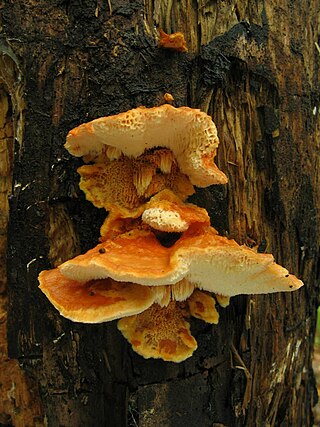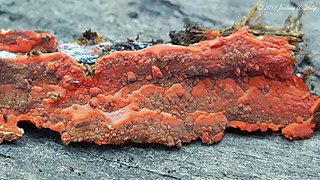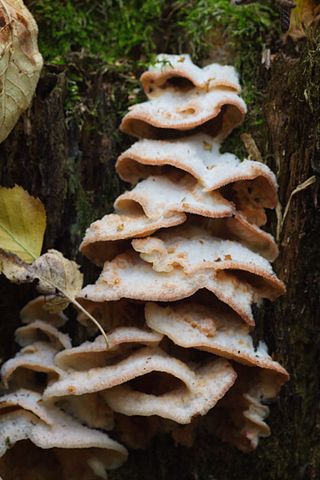
Gustav Karl Wilhelm Hermann Karsten was a German botanist and geologist.

Coprinopsis is a genus of mushrooms in the family Psathyrellaceae. Coprinopsis was split out of the genus Coprinus based on molecular data. The species Coprinopsis cinerea is a model organism for mushroom-forming basidiomycota, and its genome has recently been sequenced completely.

Ganoderma is a genus of polypore fungi in the family Ganodermataceae that includes about 80 species, many from tropical regions. They have a high genetic diversity and are used in traditional Asian medicines. Ganoderma can be differentiated from other polypores because they have a double-walled basidiospore. They may be called shelf mushrooms or bracket fungi.

Lucien Quélet was a French naturalist and mycologist. Quélet discovered several species of fungi and was the founder of the Société mycologique de France, a society devoted to mycological studies.

The Meruliaceae are a family of fungi in the order Polyporales. According to a 2008 estimate, the family contains 47 genera and 420 species. As of April 2018, Index Fungorum accepts 645 species in the family.

Phlebia is a genus of mostly crust fungi in the family Meruliaceae. The genus has a widespread distribution. Phlebia species cause white rot.

Mycoaciella is a genus of corticioid fungi in the family Meruliaceae. The genus was circumscribed by John Eriksson and Leif Ryvarden in 1978. After microscopic examination of the three species then in the genus, Karen Nakasone proposed to synonymize Mycoaciella with Phlebia.

Hapalopilus is a genus of poroid fungi in the family Polyporaceae. The genus is widely distributed. The generic name combines the Ancient Greek words ἁπαλός ("tender") and πιλος ("cap"). Hapalopilus was circumscribed by Finnish mycologist Petter Adolf Karsten in 1881.

Liotia is a genus of very small sea snails, marine gastropod mollusks in the family Liotiidae.
Hemipolygona centrifuga is a species of sea snail, a marine gastropod mollusk in the family Fasciolariidae, the spindle snails, the tulip snails and their allies.
Pteropurpura centrifuga is a species of sea snail, a marine gastropod mollusk in the family Muricidae, the murex snails or rock snails.

Phlebia incarnata is a species of polypore fungus in the family Meruliaceae. It is inedible.

Phlebia radiata, commonly known as the wrinkled crust, is a common species of crust fungus in the family Meruliaceae. It is widespread in the Northern Hemisphere. It grows as a wrinkled, orange to pinkish waxy crust on the decaying wood of coniferous and deciduous trees, in which it causes a white rot. The fungus was first described scientifically in 1821 by Elias Magnus Fries.

In Finland, Kotiranta and Niemelä introduced a widely used method for comparing the conservation values of different forest areas, based on the observation that certain wood-rotting fungi are very sensitive to the impact of human activities on forest ecosystems. Such species are slow to return to areas from where they have disappeared, so their presence is evidence of a long continuity in forest ecosystems.
Phlebia crassisubiculata is a species of crust fungus that is found in India. It was described as new to science in 2010. The type specimen was found growing on the underside of a decaying stump of gymnospermous wood in the Dalhousie hills of Himachal Pradesh. The specific epithet crassisubiculata refers to the "conspicuously thick subiculum" that is characteristic of the species.

Phlebia coccineofulva, commonly known as the scarlet waxcrust, is a species of crust fungus in the family Meruliaceae. It was described as a new species by Lewis David de Schweinitz in 1832. The fungus is found in North America, continental Europe, and northern Asia, where it grows as a saprophyte on decaying stumps and woody forest debris.

Phloiophilus edwardsii is the sole known species of the beetle family Phloiophilidae in the superfamily Cleroidea. It is native to Europe. The larvae are mycophagous, and have been observed feeding on basidiomycetes of the genus Phlebia growing on dead oak branches. The larvae are active during the winter period, before entering the soil to pupate in late spring-early summer.

Phlebia tremellosa, commonly known as trembling Merulius or jelly rot, is a species of fungus in the family Meruliaceae. It is a common and widely distributed wood-decay fungus that grows on the rotting wood of both hardwood and conifer plants.

Arctoparmelia centrifuga or the concentric ring lichen is a species of ring lichen belonging to the family Parmeliaceae.
Anzia centrifuga is a species of foliose lichen in the family Parmeliaceae. It is found only on one volcano on Porto Santo in the Madeira Archipelago, where it grows on rocks.
















